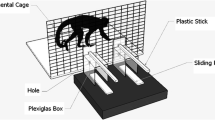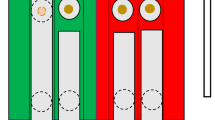Abstract
In the present study, two experiments investigated the effect of a change in food availability on selection between two food items at different deprivation levels. In the first study, 6 pigeons chose between a nonpreferred food item (i.e., checkers) after a fixed delay and a preferred food item (i.e., corn) after an adjusting delay. The delay to the preferred food item adjusted depending upon the pigeon’s choices. The dependent measure was the amount of delay added to corn to produce indifference at 70% and 95% of body weight. Results showed that less delay had to be added when pigeons were more deprived. In the second study, the availability of both corn and checkers was varied by manipulating the amount of each food item presented to the pigeons at 70% and 95% of body weight. The dependent measure was the amount of each item taken. For the nonpreferred food item, consumption depended on an interaction between deprivation and availability. A decrease in availability only affected checker consumption when body weight was at 70%. Together these two studies showed that the effect of a change in food availability on selectivity was greater when pigeons were more deprived.
Similar content being viewed by others
References
GOSS-CUSTARD, J. D. (1977). Responses of the redshank, Tringa Totanus, to the absolute and relative prey densities of two prey items. Journal of Animal Ecology, 46, 867–874.
Krebs, J. R. (1978). Optimal foraging: Decision rules for predators. In J. R. Krebs & N. B. Davies (Eds.), Behavioural ecology (pp. 23–63). Oxford: Blackwell.
KREBS, J. R., ERICHSEN, J. T., WEBBER, J. I., & CHARNOV, E. L. (1977). Optimal prey selction in the great tit (Parus majot). Animal Behavior, 25, 30–38.
LOGUE, A. W., & PENA-CORREAL, T. E. (1985). The effect of food deprivation on self control. Behavioural Processes, 10, 355–368.
LACHER, T. E., Jr., WILLIG, M. R., & MARES, M. A. (1982). Food preferences as a function of resource abundance with multiple prey types: An experimental analysis of optimal foraging theory. American Naturalist, 120, 297–316.
MAZUR, J. E. (1987). An adjusting procedure for studying delayed reinforcement. In M. L. Commons, J. E. Mazur, A. Nevin, & H. Rachlin (Eds.), Quantitative analyses of behavior: Vol. 5. The effect of delay and intervening events on reinforcement value (pp. 55–73). Hillsdale, NJ: Erlbaum.
MAZUR, J. E. (1988). Choice between small certain and large uncertain reinforcers. Animal Learning & Behavior, 16, 199–205.
MAZUR, J. E., SNYDERMAN, M., & COE, D. (1985). Influences of delay and rate of reinforcement on discrete trial choice. Journal of Experimental Psychology: Animal Behavior Processes, 11, 565–575.
MILLER, H. L., Jr. (1976). Matching-based hedonic scaling in the pigeon. Journal of the Experimental Analysis of Behavior, 26, 335–347.
MOON, R. D., & ZEIGLER, H. P. (1979). Food preferences in the pigeon (Columbia livia). Physiology and Behavior, 22, 1171–1182.
PYKE, G. H., PULLIAM, H. R., & CHARNOV, E. L. (1977). Optimal foraging: a selective review of theory and tests. Quarterly Review of Biology, 52, 137–154.
RECHTEN, C., AVERY, M., & STEVENS, A. (1983). Optimal prey selection–why do great tits show partial preferences. Animal Behavior, 31, 576–584.
SCHOENER, T. W. (1971). Theories of feeding strategies. Annual Review of Ecology and Systematics, 11, 369–404.
WALKER, S. (1987). Animal learning: An introduction. New York: Routledge & Kegan Paul Inc.
Author information
Authors and Affiliations
Corresponding author
Additional information
This research was conducted in the Harvard Psychological Laboratory, William James Hall, Cambridge, MA while Terry Belke was in the graduate program in the Department of Psychology, Harvard University and while Tammi Kwan was in the graduate program in the Department of Psychology, University of Alberta, Edmonton, Canada.
Rights and permissions
About this article
Cite this article
Belke, T.W., Kwan, T.Y. The Effect of Changes in Availability on Food Selection at Different Levels of DeprIvation. Psychol Rec 50, 529–541 (2000). https://doi.org/10.1007/BF03395369
Published:
Issue Date:
DOI: https://doi.org/10.1007/BF03395369




